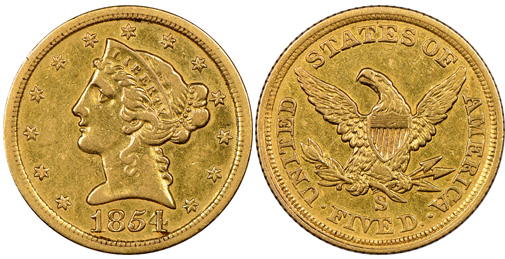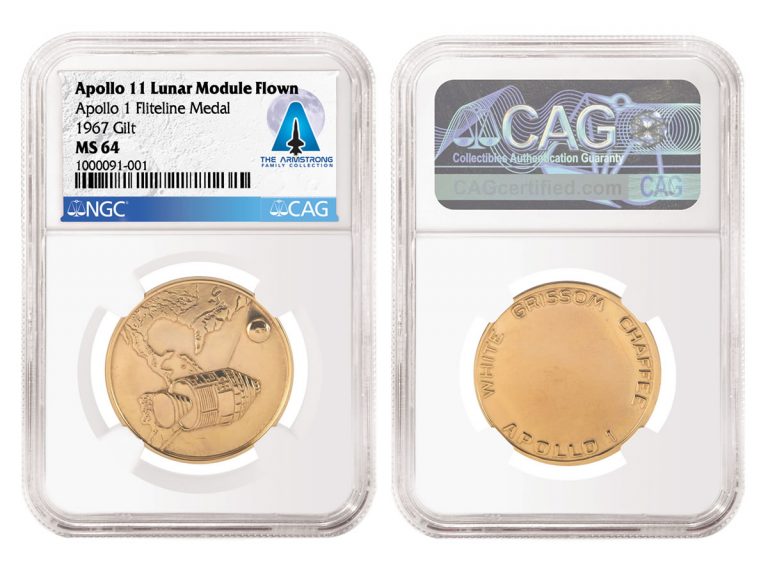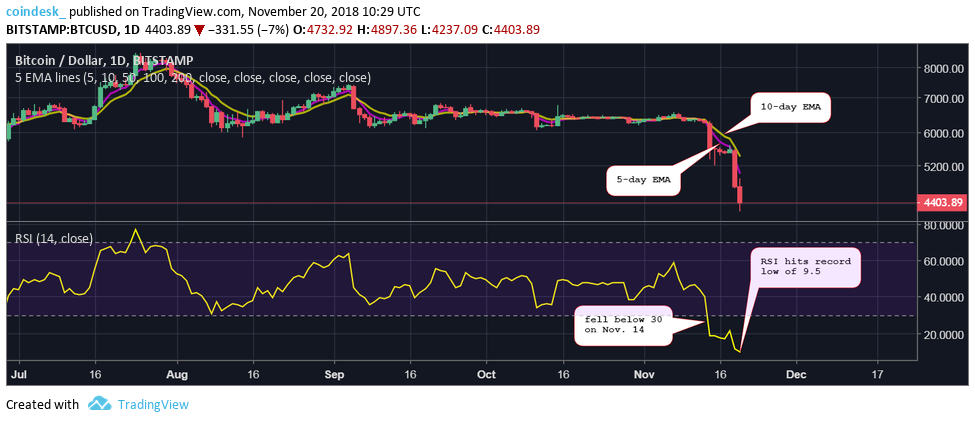With gold and silver bullion values trending mostly downward in 2018, you wouldn’t expect a great deal of exciting news from the world of numismatic auctions. After all, activity in the bullion market tends to affect enthusiasm for coin sales overall.
Of course, if collectors were completely rational, they would buy when prices of bullion-related items are decreasing and sell when prices are rising. This almost never happens, however, as people are attracted by rising prices and depressed by falling ones. This seems to be true even when the items of interest are little affected by bullion prices. After all, what difference to the value of an 1894-S dime does the price of the silver in it make?
One way to gauge the health of the numismatic market is to look at what happened on the auction scene in 2018. And that’s what I’ll do in this article.
If you’ve followed my auction surveys this century, you know that I’ve opened them by looking at the number of million-dollar coins sold at auction. Although 2014 and 2015 were banner years with 14 and 13, respectively, I counted only two in 2016 and the same number in 2017. 2018 fared much better than the previous two years.
This year I counted eight million-dollar numismatic items. Note that I didn’t say they were all coins; one was a $1,000 bill, but more on that later. In addition, I should put an asterisk after the number because two of the seven-figure items changed hands privately rather than at auction.
The first million-dollar coin was a foreign rather than a U.S. coin. Dated 1621, the gold 100 ducat of Zygmunt III Wasa commemorated a Polish victory over the Ottoman Empire at Khotyn (near Khotyn, Ukraine). One of the largest European gold coins ever struck, only six examples are known. This one carried an EF grade and was estimated to sell for $2 million. Actually, the winning bid was “just” $1,800,000, which, with a 20 percent buyer’s premium, brought the total paid to $2,160,000. This represented a hefty advance over the $1,380,000 it brought in 2008. All auction figures in this article include a buyer’s premium, typically 20 percent.
Part of the Classical Numismatic Group’s January sale, Triton XXI, the $2+ million coin helped the group achieve a total of nearly $15 million. With a clearance rate north of 98 percent, CNG reported that approximately 245 lots sold for more than $10,000 apiece, with nine bringing more than $100,000 each.
The second million-dollar item I found traded hands privately rather than at auction, although Heritage Auctions was involved in the deal. Graded MS63 by Numismatic Guaranty Corpoation, with a CAC sticker, the 1787 Brasher doubloon found a new owner for a price over $5 million. Also part of the deal was Adam Crum of Monaco Rare Coins. Crum stated that his company had “. . . had the honor of owning this amazing piece of history since 2014 and take pride in knowing that our firm will be forever etched into its provenance.” Heritage had previously sold the coin at auction in 2014 for $4.58 million.
Million-dollar coin number three was an example of the so-called “King of American Coins,” the 1804 silver dollar. Called the Mickley-Hawn-Queller specimen for its recent owners, it’s an example of the Class I or “original” 1804s. One of just eight dollars, it was graded PR62 by Professional Coin Grading Service. As part of the Geyer Family Collection, this rare piece realized $2.64 million at Heritage’s June 14-17 Long Beach, Calif. auctions.
Although $2.64 million sounds like a lot and is a lot, it’s worth noting that the same piece brought $3,877,500 in Heritage’s 2013 Chicago Signature Auction. This proves that even extremely popular and rare coins are not immune to the vicissitudes of the market.
Heritage’s overall take at Long Beach exceeded $18.1 million. Another big-ticket item in the sale nearly achieved a million-dollar price: the finest known 1793 Chain America With Period cent, graded MS65 BN by PCGS, with CAC approval. Once part of the Louis E. Eliasberg Sr. collection, this magnificent piece realized $990,000. Eliasberg was the only collector to have put together a collection consisting of all U.S. coins.
Heritage Auctions sold another million-dollar coin on Aug. 16 in Philadelphia as part of its ANA World’s Fair of Money auctions. The coin was a 1792 pattern $10 gold piece featuring a bust of George Washington on its obverse. Graded XF45 Star by NGC, this unique coin, which may once have been carried by George Washington himself, went for $1.74 million.
Part of the Eric P. Newman collection, this was the first time this particular item appeared at auction since 1890. Newman purchased the coin in 1942 and considered it his favorite piece. According to a Coin Dealer Newsletter blog, “Newman, a numismatic scholar, died in 2017 at age 106 and is credited [with] creating one of the nation’s most significant coin collections. Since 2013, more than 19,000 lots from Newman’s collection have sold for over $72.9 million at auctions conducted by Heritage, with all net proceeds benefiting [sic] various charities.”

A previously unknown 1854-S gold $5 sold for $2.16 million in a Heritage auction in August.
Yet another million-dollar coin helped bring Heritage’s total in Philadelphia to over $40 million. A newly discovered 1854-S $5 gold piece, graded XF45 by NGC, brought in $2.16 million. Only four examples are known of this date, with one residing in the Smithsonian, one in a Texas collection, and one that’s been missing since stolen from the duPont family in 1967. It’s important to note that the coin in this sale was not the missing duPont piece.

The finest 1913 Liberty Head nickel sold in a Stack’s Bowers Galleries auction for $4.56 million in August.
Not to be outdone by their competitors, Stack’s Bowers Galleries offered a coin in their ANA World’s Fair of Money auctions that was guaranteed to achieve million-dollar status, the finest example of the five 1913 V-nickels. Graded Superb PR66 by PCGS, the coin was consigned by the family of Dr. William Morton-Smith, a California physician. Morton-Smith was the most recent owner of the coin known as the Eliasberg specimen.
With the buyer’s premium, the Eliasberg 1913 V-nickel earned a whopping $4.56 million. Although that’s certainly a big figure befitting this popular, rare coin, the coin sold for $4.15 million in 2005. Over the 13-year time period, the increase works out to less than 1 percent a year. Again, this is perhaps a reflection of a soft market for rare numismatic material.
Looked at another way, however, the increase in value came during a period of quite low inflation. Thus, the rate of increase is perhaps better than would have been achieved by having the money in a money-market fund at an extremely low rate of interest.
Next up is a private treaty sale by Brian Hendelson, president of Classic Coin Company in Bridgewater, N.J. Hendelson received $1,985,000 for the finest-known example of the 1792 half disme. Graded MS68 by PCGS, this tiny coin was owned by Thomas Jefferson, who at the time was the secretary of state for the new government. Unlike the present-day secretary of state, that office in 1792 was responsible for the U.S. Mint.
If being in the possession of Thomas Jefferson weren’t enough, the coin was part of the collection of the Mint’s first director, David Rittenhouse. According to Hendelson, “It was purchased by the owner of The Dazzling Rarities Collection. He wants to remain anonymous while he’s assembling an amazing collection of the most famous and wonderful United States rare coins.” Obviously, the Rittenhouse 1792 half disme is a great addition to a dazzling rarities collection.
Hendelson displayed the coin in the American Numismatic Association’s Museum Showcase at ANA’s World’s Fair of Money in Philadelphia. He had also displayed the piece at two previous summer ANA conventions (2013 and 2017) and at Mount Vernon, George Washington’s Virginia home, in 2014 and 2015.
In late October, Stack’s Bowers offered a less expensive example of the 1792 half disme in its auction at the Whitman Coin & Collectibles Winter Expo in Baltimore. Graded MS63 by PCGS, with CAC sticker, the coin realized $240,000.
The final million-dollar seller I found is not a coin but a piece of paper money. Of course, it’s not just any piece of paper money; it’s the Series 1890 $1,000 Treasury Note known as the “Grand Watermelon” note (named for the shape of the zeroes on the reverse of the bill) by paper money collectors. The Grand Watermelon note was sold in the Stacks’s Bowers auction in Baltimore in late October.
With a total take of slightly more than $2 million, the Grand Watermelon note helped the Stack’s Bowers firm achieve the sale of slightly more than $8.6 million. This was the third part of their sale of the Joel R. Anderson collection of U.S. paper money. Part IV is scheduled for February 2019. Overall, the collection has brought in more than $26 million to the Stack’s Bowers coffers.
In the sale of the first part of the Anderson collection held in Baltimore in March, two bank notes nearly achieved a million dollars. The first was an 1863 $1,000 Legal Tender Note graded About New 58 by PCGS Currency, whereas the second was a Choice About New 55 1880 $1,000 bill. Both notes sold for the same amount, $960,000.
* * *
Key date coins in popularly collected series tend to do well at auction, and I found several instances of this in 2018 auctions. There are two types of keys, those with low mintages and perhaps poor survival and those that are considered condition keys, relatively common in low grades but rare in high grades. Occasionally, both conditions apply.
For example, take the 1926-S Buffalo nickel. Its 970,000 mintage is the lowest of any normally issued Buffalo nickel. However, it’s relatively common in low grades and priced accordingly. An outstanding example of this key date realized $99,000 in Heritage Auctions’ FUN sales in early January. PCGS had graded it MS65, and it had a CAC sticker.
In the same sales, two mint-state examples of the overdate key, 1918/7-D, brought $45,600 and $66,000. Both graded by PCGS, the least expensive coin was an MS62, with CAC approval, whereas the more expensive example carried an MS64 grade.
As an example of a condition rarity, a 1919-D Walking Liberty half dollar, PCGS-graded MS65 Secure, with CAC sticker, realized an astounding $240,000 in the Heritage FUN sales. Think about it: someone was interested enough in a hundred-year-old half dollar to pay nearly a quarter of a million dollars for it!
Another good example of a condition rarity, a PCGS-certified MS66 1895-O Morgan dollar, earned big bucks at a Stack’s Bowers auction during the ANA World’s Fair of Money. This spectacular coin sold for an astonishing $336,000.
Perhaps the ultimate condition rarity sold for big bucks in a Great Collections auction in late January. It was a 1943 Walking Liberty half dollar, which had a mintage of more than 53 million pieces. This particular specimen had received a PCGS grade of MS68, and it also had a CAC sticker. When the bidding ceased, the buyer of this finest available 1943 50 cents had paid slightly more than $18,000!
If you’re a Morgan dollar collector with a large budget for coin purchases, you might want to add an 1895 dollar to your collection. This is a coin that is only available as a proof issue, of which just 880 were minted. If you consider the 1895 dollar to be one of the keys to completion of the Morgan dollar set, this is a coin you’ll want to purchase. The Heritage Auction sale in September in Long Beach sold an NGC PR65 specimen, with CAC sticker, for a “mere” $87,000. At the same sale, another key date, the 1889-CC, graded MS62 by PCGS, sold for $36,000.
A couple of months later, Heritage offered another 1895 dollar at an auction in Dallas, Texas. Graded PR66 by PCGS, it sold for $102,000.
* * *
Intermingled with all the “normal” coins and paper money offered at auction in 2018 were a few oddball items. For example, in the Stack’s Bowers auction in Baltimore in March, a “mule” was sold for $192,000. Of course, this was not an animal but a coin for which the obverse and reverse dies were mismatched. The coin for sale was a Sacagawea dollar reverse paired with a Washington state quarter obverse. The planchet was that of the “gold” dollar, and the coin had received an MS67 grade from NGC.
Seventeen of this particular mule are known, with 12 of them in one collection. Bowers and Merena Auctions sold the discovery example for $29,900 in the August 2000 ANA Millennium Sale.
Another oddity that brought big money at auction was a Nobel Prize gold medal awarded in 2005 to Thomas C. Schelling. According to the auction firm, Nate D. Sanders Auctions in Los Angeles, the recipient was a Harvard economics professor, who “. . . was best known for his expertise and elaboration of game theory, which many credited with reducing the risk of nuclear war.” Schelling’s theory came to be known as the “Madman Theory,” and Richard Nixon used it in negotiations with North Vietnam and the Soviet Union. Many experts think that both Kim Jong Un and Donald Trump are employing this strategy in their current negotiations.
Current Nobel Prize gold medals are made of 18-karat gold with a 24-karat gold plating. The intrinsic value of the medal at current gold prices is close to $6,000. This medal, with proceeds to go to the Southern Poverty Law Center, sold for $187,500, which is more than 30 times its melt value.
After reading about all the 5-, 6- and 7-figure rarities in this survey, you might be forgiven for concluding that the major auctions held any year don’t include coins for collectors with limited budgets for numismatic purchases. Fortunately, this conclusion is unwarranted. In even the biggest auctions, there are always some coins that fit even limited budgets.
For example, in a Heritage auction on Dec. 4, 2018, you could have bought an 1864 bronze Indian cent graded MS63 BN by NGC for just $114. Another possibility in the same auction was a 1911 Lincoln cent graded MS65 RB (looked all red to me) that sold for $138. Or, what about the semi-key date 1931-S graded MS65 RB by NGC? That splendid coin sold for $264.
In a Stack’s Bowers auction in November, a PCGS-graded AU58 1922-D Lincoln cent went for $75. Or what about a PCGS-graded MS65 FBL 1958-D Franklin half dollar for just $80? In the same sale, an MS63 1903 Liberty Head nickel, graded by PCGS, realized $85.
Great Collections Certified Coin Auctions often offers inexpensive coins in its auctions. I mentioned Great Collections earlier in connection with the sale of an MS68 1943 half dollar for a fraction over $18,000. In a sale in September, Great Collections sold a 1943 half dollar in MS65 (PCGS) with CAC sticker for $165. In April, Great Collections parted with a PCGS-graded 1938-D half dollar in VF35 for just $113.
I could go on like this, but I suspect you get the picture: virtually all auction sales, no matter how many big-ticket items they contain, also include coins within reach of virtually every collector, no matter how limited the budget. If you didn’t bid in any auctions in 2018, make a note to do so in 2019. It’s possible your purchase will be included in some future survey of numismatic auction activity.




